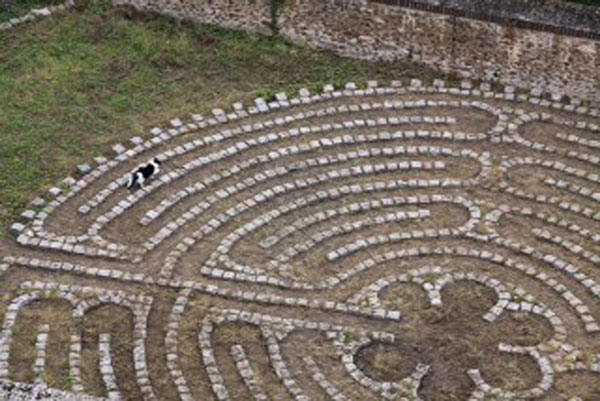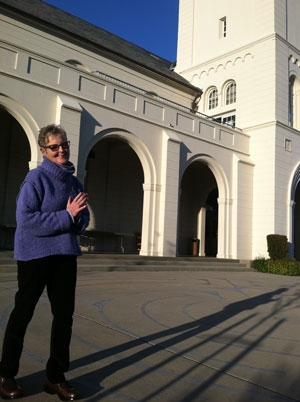

January 2014
Labyrinths were recently featured in the Huffington Post.
Click here for the article (see if you can spot the maze!)
Donor Spotlight
by Rita Canning, Development Coordinator
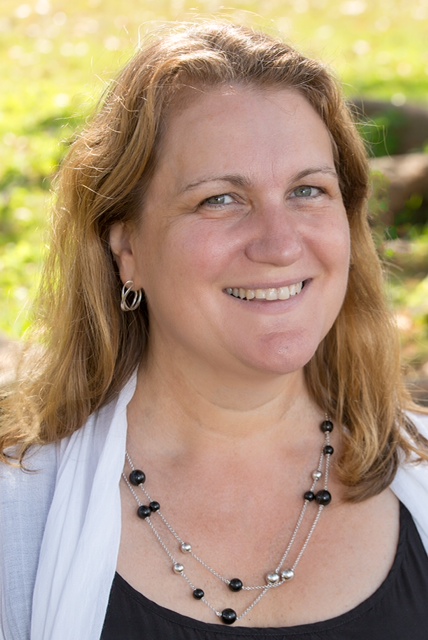
As we begin a bright New Year, my interview this month is with Emily Simpson. Emily lives in Australia and is just finishing up her term as a Veriditas Board Member. She also serves Veriditas as a major donor, facilitator and labyrinth creator and it has been a real joy to interview her. Rita: When did you first encounter the labyrinth? Emily: The first time I walked a labyrinth was in 2009 at Grace Cathedral. I was doing a course with Jean Houston and someone suggested walking the labyrinth. I didn’t know what it was but I went anyway because I thought I could learn from it. And I ended up walking it again and again and came back the next morning and walked it for two or three more hours. I fell in love with it. I felt held by the geometry, the structure of its winding path (the masculine) and received by the flow of it, the mystery (the feminine). I feel the labyrinth is the integration of the masculine and the feminine. At the time I was dealing with several losses and had a lot of tangled grief. As I walked the labyrinth that grief began to lift off me. I don’t know why but it just made me feel better. It so healing and balancing because I feel held and blessed by it at the same time. It’s a unique thing. There’s nothing else like this. Rita: How did you get involved with Veriditas? Emily: I wanted to find out everything thing I could so I bought books on the labyrinth and started searching on line. And I came across Veriditas and saw the program in Chartres. I went to Chartres and spent a week doing the training with Lauren. Lauren is such a magnificent teacher and holds such a beautiful space. She holds groups with such a deft hand and such a light touch. It was very inspiring to see her in that capacity. It was sensational. Such a rich and rewarding experience it was that whole week. The labyrinth in Chartres is so alive. When I first stepped on it I felt ill and ecstatic at the same time because it was so powerful - it truly feels like a portal to somewhere “other”. When I came back to Australia I ordered a canvas labyrinth from Robert Ferre and started holding candlelit walks at an art gallery. Lee Matthew was in my small group at Chartres. We had become friends and she asked me if I wanted to be on the Veriditas Board. I sort of fell off my chair because it was such a huge, extraordinary thing. Because of all the losses I experienced I had sort of cocooned myself in the forest and the labyrinth was the only thing that could pull me out. You know those arcade machines where there is a claw that picks up a prize? I felt like this claw had come along and picked me up out of the forest and dragged me into the center of the labyrinth to this wonderful community. It was truly life altering to be recognized as part of a tribe and I’m eternally |
grateful for that. After that I would travel, but only go to those places that had a labyrinth nearby. I’d go from labyrinth to labyrinth. Rita: Would you talk about work you have done with the labyrinth? Emily: I walk often in Centennial Park in Sydney and one day I thought that it would be wonderful to have a labyrinth, a nondenominational sacred space in the park. I wanted to create something that was accessible to everyone but also a labyrinth for me to walk! I never tried to do anything like that before. I started to gather a community around me from the candlelit walks and some friends helped me write a proposal for the city’s Board of Trustees and, like a miracle, the Board accepted the proposal. It was an astonishing thing. The labyrinth Gods were smiling and helping. The Board said if I could raise the money then I could build it. I’ve never done fundraising before and I wouldn’t have done this for anything less than the labyrinth. So I just started holding events and telling people about it. It didn’t take that long. One of the first big donors gave $50,000 right away and that started it rolling. There was some sort of magic around the labyrinth - I felt compelled that this was meant to happen and that it was totally beyond my ego. My love for the labyrinth was bigger than my fears. I was guided somehow. I then got permission to paint a labyrinth in the field where the sandstone labyrinth would be built so some people could walk it before the permanent one was built. This made it more real for people. The labyrinth is very new to Sydney and most people didn’t know what it was. This way they could see that it was lovely and peaceful and that there was nothing to fear. So I started doing events around there. The most significant event I did was an interfaith walk with a Catholic priest, an Anglican priest, a Rabbi, an Imam, two Buddhist monks, a Sikh and an aboriginal Elder. They loved the idea. They were so grateful and openhearted so we had this big event. They each spoke about the journey through life as a sacred path according to their sacred texts and traditions. And they all walked it together. Seeing the Imam and the Rabbi shaking hands in the middle of the labyrinth was really incredibly moving. It was a beautiful moment that demonstrated what the labyrinth is capable of. I see the labyrinth as the “field outside right and wrong” (taken from Rumi). It felt outside all religion and all of our ideas of how we’re meant to love. The labyrinth will be completed by the end of this year at the latest. The local paper took pictures of all these spiritual leaders standing in the center of the labyrinth and put it in the local paper.Rita: Why do you donate to Veriditas? Emily: I think we need more labyrinths on the planet, that they are very important. We need more people to hold the lantern and show the way to how the labyrinth works in the community and for peoples’ personal journey. Veriditas is the leader in the field and is the best at it. I love the work. It’s done really beautifully and really well. Lauren’s vision has been so nourishing for so many people. |

Facilitator Spotlight: Carol Howard Wooton
By Chris Farrow-Noble, Council Member
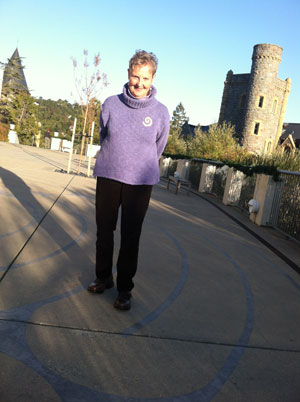 For this Facilitator Spotlight, I spoke with Carol Howard Wooton, MFT, in Marin County, California. I had read her response on the Veriditas ListServe to a woman who had met several labyrinth walkers who had suffered brain injuries. Carolʼs encouraging response reflected her experience and insight with this group of people. For this Facilitator Spotlight, I spoke with Carol Howard Wooton, MFT, in Marin County, California. I had read her response on the Veriditas ListServe to a woman who had met several labyrinth walkers who had suffered brain injuries. Carolʼs encouraging response reflected her experience and insight with this group of people.How did you find the labyrinth, or did the labyrinth find you? My spiritual quest began at age 38, after having a cerebellar stroke in 1985, only three years after being licensed. It affected my gait, balance and coordination, and the pace at which my brain worked. In 90ʼs I joined a monthly drumming group. We met after hours in Grace Cathedral in San Francisco; drummed, moved, and chanted through the Cathedral. The first time I came upon the tapestry labyrinth I was captivated by its shape and inviting texture. I often returned to Grace to walk it. It became my home labyrinth. How did your experience with the labyrinth affect your healing process? I was determined to learn to walk again. Walking the labyrinth commanded my entire focus and attention. My balance was unsteady. The warm, solid texture of the tapestry and the “give” in the material made it safe. The wide paths helped me retain my balance and were soft when I lurched while changing directions in the turns. The textured sensation under my feet anchored my attention, providing grounding. If I looked ahead to see where I was going, my head would swim and I would lose my balance. One step at a time was the only way to stay the course. On the path with others provided solace for my “private” grief. Walking became embodied prayer...- metaphor became reality. What was the most challenging aspect of your personal recovery and rebuilding of your life? I didnʼt know where I belonged, there was no map. While “in recovery” I had to face I could never fully recover who “I” was before. Now I prefer the word “revision.” “I” had had plans, that had been irretrievably interrupted. Letting go of joyful competencies and life dreams was extremely difficult psychologically. Healing required surrender to a solo descent while simultaneously reconstructing a new me, a new life ....reviewing what mattered. I was blessed to have access to wise psychotherapists, Physical therapist, healers and teachers. Wounded Healers became role models...encouraging me to test and use my skills as a teacher and psychotherapist. Buddhist practice cultivated moment to moment awareness. Angeles Arrien strengthened my resolve to live a meaningful and whole hearted life. Twenty nine years of living with stroke and two decades of leading groups for stroke survivors as well as individual and couple psychotherapy has led me to know that awareness IS who we are, everything changes, joy and sorrow, grief and gratitude live side by side.Where and with whom do you do your labyrinth work? At the moment I am a lapsed labyrinth facilitator, although in the past I used finger labyrinths and brought Keeping Hope Alive group members to |
walk labyrinths at Grace Cathedral and St. Anselmo Theological Seminary. I needed to put my work aside as my mother was dying and during my initial grieving. I know that working with people who have had strokes or Traumatic Brain Injury (TBI) is my life work. I am actively reviving that commitment. As I move back out into the world after a very private time, I am renewing my intention to incorporate the labyrinth in my work and my life, trusting my inner knowing. How do you find persons with TBI, or how do they find you? I am launching a new Keeping Hope Alive Group for folks with strokes at the Bay Area Brain Injury Network (www.binba.org.) People may also find me through KeepingHopeAlive.org . My writing is another accessible resource (see Psychotherapy.net for Carolʼs article, entitled, Grief and Gratitude: Working with Stroke Survivors. What recommendations would you offer people living with TBI an/or to labyrinth facilitators who have the opportunity to work with this group? I would encourage facilitators to listen carefully to their stories and respond with curiosity about their present situation and feelings. Use the metaphors of the labyrinth: Take one step at a time; the path is not straight, linear or predictable; your path is your own. Uniqueness is a challenge and an opportunity. Healing requires embracing both/ and, welcoming everything. Grieving & reconstructing take time. Move as fast as your slowest part requires. Please tell us about a particularly memorable experience on the labyrinth. I remember a gentleman on the labyrinth at Grace Cathedral who was attending my “Keeping Hope Alive” group. He was seriously impaired in his speech and walking. Several people offered him assistance, including his daughter, but he refused. He began walking with his four-pronged cane in one hand, his affected arm bent at the elbow and his hand folded into his body. With great precision and effort he kicked one leg out to the side and drew the other forward. When he came out , the smile on his face and his bearing spoke Triumphant Joy. |
Product Highlight from our Product Partner, iSpiritual
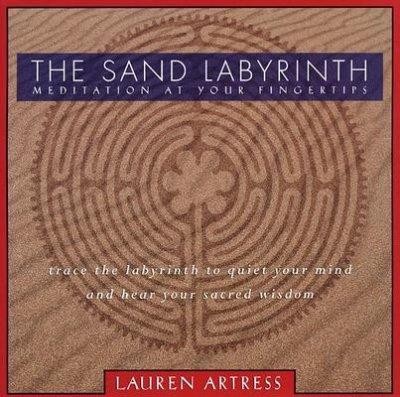 Meditation at Your Fingertips Use this guide to calm yourself, focus your thinking, find solutions to problems, and open yourself to your own inner wisdom. For thousands of years, archetypal labyrinth patterns have been used as a powerful tool for resolving problems, access to inner peace, and spiritual alignment. A simple yet highly effective practice, walking or tracing a labyrinth quiets the mind and takes you to a place where you can hear your own wisdom with clarity and calmness. |
Author Lauren Artress, founder of Veriditas, offers a lovely labyrinth kit, to be used anywhere, anytime, on tabletops, desktops, beds or laps. Included in The Sand Labyrinth are:
Click here to order. 
|
Global Healing ResponseThe Global Healing Response, founded in 2005 by Council member Ellen Bintz Meuch, offers an annual theme and quarterly ideas and information to enrich labyrinth walks. The GHR theme for 2014 is Unity and the focus for this quarter is Consensus. The quote is by Martin Luther King, Jr.: “A genuine leader is not a searcher for consensus but a molder of consensus.” - If each of us could host or personally take the time for a GHR labyrinth walk, think of the unified healing energy we could create! The first quarter is posted on the website, www.globalhealingresponse.com. We encourage you to visit the site soon and often. |
Little Miracles on the PathEach month, Linda Mikell, secretary to the Veriditas Council and New England Regional Representative, emails a Little Miracles on the Path story to 439 facilitators who have signed up for them. Facilitators from all over the world send her stories about interesting, touching events that happen at their labyrinth walks. If you would like to receive these stories, please contact Linda ([email protected]). Please don’t forget to send your story when you have one. Little Miracles are archived on the Facilitators Portal of the Veriditas Website. |
Different Meaning for Catwalk
Thank you to Anne Schumacher for permission to share this great photo
of a cat walking the St.Yves Labyrinth in Chartres, France.
